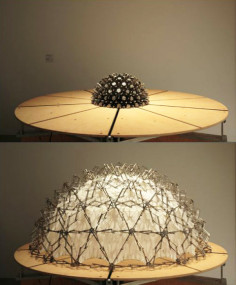Chuck Hoberman
hoberman sphere

source: buildingdynamics
Chuck Hoberman is an inventor, internationally known for his “transformable structures.” Through his products, patents, and structures, Hoberman demonstrates how objects can be foldable, retractable, or shape-shifting. Such capabilities lead to functional benefits: portability, instantaneous opening, and intelligent responsiveness to the built environment. Hoberman is the founder of Hoberman Associates, a multidisciplinary practice with clients ranging across sectors including consumer products, deployable shelters, and space structures. Examples of his commissioned work include the transforming LED screen that served as the primary stage element for the U2 360° world tour and the Hoberman Arch in Salt Lake City, installed as the centerpiece for the Winter Olympic Games (2002). Other noteworthy commissions include a retractable dome for the World’s Fair in Hanover, Germany (2000); the Expanding Hypar (1997) at the California Museum of Science and Industry; the Expanding Sphere (1992) at the Liberty Science Center, Jersey City, New Jersey; and the Expanding Geodesic Dome (1997) at the Centre Georges Pompidou in Paris. Hoberman’s work has been exhibited several times at the Museum of Modern Art in New York. He won numerous awards including the Chrysler Award for Innovation and Design in 1997. Hoberman is a Visiting Scholar at Harvard University’s Wyss Institute for Biologically Inspired Engineering.
.
.
.
.
.
.
.
source: hoberman
Nowhere do the disciplines of art, architecture, and engineering fuse as seamlessly as in the work of inventor Chuck Hoberman, internationally known for his “transformable structures.” Through his products, patents, and structures, Hoberman demonstrates how objects can be foldable, retractable, or shape-shifting. Such capabilities lead to functional benefits: portability, instantaneous opening, and intelligent responsiveness to the built environment.
Hoberman is the founder of Hoberman Associates, a multidisciplinary practice with clients ranging across sectors including consumer products, deployable shelters, and space structures. Examples of his commissioned work include the transforming LED screen that served as the primary stage element for the U2 360° world tour and the Hoberman Arch in Salt Lake City, installed as the centerpiece for the Winter Olympic Games (2002). Other noteworthy commissions include a retractable dome for the World’s Fair in Hanover, Germany (2000); the Expanding Hypar (1997) at the California Museum of Science and Industry; the Expanding Sphere (1992) at the Liberty Science Center, Jersey City, New Jersey; and the Expanding Geodesic Dome (1997) at the Centre Georges Pompidou in Paris.
Hoberman’s work has been exhibited several times at the Museum of Modern Art in New York. In 2008 his commissioned installation Emergent Surface was part of the exhibit “Design and the Elastic Mind.”
In 2008, alongside Buro Happold Principal Craig Schwitter, Hoberman formed the Adaptive Building Initiative (ABI). The joint venture united Hoberman’s design vision with Buro Happold’s 30 years of engineering excellence to develop retractable façades, responsive shading and ventilation, operable roofs, and canopies for the built environment. Between 2009 and 2010, ABI realized four adaptive architectural installations: an adaptive façade for the POLA’s Ginza, Tokyo headquarters; an operable roof for Aldar Central Market in Abu Dhabi; a dynamic entrance for the Wyss Institute at Harvard University; and a kinetic façade for the Simons Center at Stony Brook University, New York.
Hoberman holds a bachelor’s degree in sculpture from Cooper Union and a master’s degree in mechanical engineering from Columbia University. He won the Chrysler Award for Innovation and Design in 1997.

